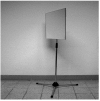Archetypal-imaging and mirror-gazing
- PMID: 25379264
- PMCID: PMC4219253
- DOI: 10.3390/bs4010001
Archetypal-imaging and mirror-gazing
Abstract
Mirrors have been studied by cognitive psychology in order to understand self-recognition, self-identity, and self-consciousness. Moreover, the relevance of mirrors in spirituality, magic and arts may also suggest that mirrors can be symbols of unconscious contents. Carl G. Jung investigated mirrors in relation to the unconscious, particularly in Psychology and Alchemy. However, the relationship between the conscious behavior in front of a mirror and the unconscious meaning of mirrors has not been clarified. Recently, empirical research found that gazing at one's own face in the mirror for a few minutes, at a low illumination level, produces the perception of bodily dysmorphic illusions of strange-faces. Healthy observers usually describe huge distortions of their own faces, monstrous beings, prototypical faces, faces of relatives and deceased, and faces of animals. In the psychiatric population, some schizophrenics show a dramatic increase of strange-face illusions. They can also describe the perception of multiple-others that fill the mirror surface surrounding their strange-face. Schizophrenics are usually convinced that strange-face illusions are truly real and identify themselves with strange-face illusions, diversely from healthy individuals who never identify with them. On the contrary, most patients with major depression do not perceive strange-face illusions, or they perceive very faint changes of their immobile faces in the mirror, like death statues. Strange-face illusions may be the psychodynamic projection of the subject's unconscious archetypal contents into the mirror image. Therefore, strange-face illusions might provide both an ecological setting and an experimental technique for "imaging of the unconscious". Future researches have been proposed.
Keywords: Pompei; archetype; coniunctio oppositorum; dissociation; empathy; hallucination; magic; nigredo; synchronicity.
Figures


References
-
- Gallup G.G. Chimpanzees: Self-recognition. Science. 1970;167:86–87. - PubMed
LinkOut - more resources
Full Text Sources
Other Literature Sources

